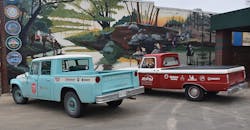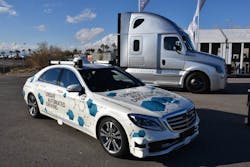It seemed like a good idea at the time: The folks at Shell were among the sponsors of a cross-country classic trucks caravan, and they asked if I’d like to drive a leg or two since the trip started in Houston (where Trailer/Body BUILDERS is based) and passed through Little Rock (my home) on its roundabout route to Detroit and the North American International Auto Show this month.
Now, I’m not a gearhead with a particular fascination for pickups from 1950s and 1960s. I’m old enough to remember my high school parking lot being full of them, but they were considered basic transportation at best—not the future collectables that our fathers assured us they’d become (we laughed) and were worth every bit of the $500 we’d earned hauling hay the summer before.
What appealed to me about taking part in the America’s Automotive Trust “Drive Home IV” was that, after a weekend in those previous mid-century modern vehicles, I’d head straight to the Consumer Electronics Show where I’d get my hands on the trucks setting the stage for this century’s transportation.
(The many vehicle makers that skipped the Detroit show to display their wares at the world’s largest technology expo says quite a bit about where transportation is heading.)
But first I got a front-seat look at where trucks have been, for better and worse. The caravan included a 1955 Chevrolet 3600, a 1965 Ford F-100, a 1962 International Travelette, and a 1957 Ford Ranchero (exactly the type of vehicle upfitters I’ve visited keep under wraps in the back of the shop).
TBB Associate Editor Jason McDaniel was on hand for the Houston opening ceremonies, with local flooding the first challenge in what would become a long, cold rainy day for the tour. I picked up the parade in Dallas, and the first vehicle to arrive (a couple of hours late) was the Chevy—on a trailer. Thrown rod, damaged crankshaft. The Travelette limped in with a failing generator. Driver Brad Philips of Hagerty felt like the astronauts on Apollo 13 as he managed the electrical load. “Do I want to run heat or wipers or lights?” he said. “Choose one.”
But there is a beauty in mechanical simplicity—especially obvious in this age of digital black box controllers where sensors detect faults and send codes to remote diagnostics computers for analysis and repair instructions, which are then relayed back to the driver, often through a fleet management system: “The truck is broken. Pull over.”
In this instance the resourceful crew of hobbyists simply “borrowed” the generator from the disabled Chevy. A late night in the garage, a stack of washers for spacers, the correct belt—and the voltmeter gauge in the International didn’t waiver during the drive from Dallas to Little Rock.
I got to drive the F-100 across Arkansas, and took the lead since I know the backroads very well. Yes, we had maps and a detailed route book, along with limited smartphone navigation in the rural wilds, but solo drivers quickly learned how tough it is to stick to a complicated route while also working a walkie-talkie and a three-on-the-tree gearshift.
The Ford, with an automatic transmission and an upgrade to a 351 V8, was a comparative pleasure to drive, however. The 10 years’ difference between it and the Chevy was very much appreciated, but the modest improvements hardly compare to the vehicle technology changes in the 50+ years since.
Still, we’re not yet living in the world of the Jetsons (again I date myself), and the rate of change anticipated at the dawn of the Rocket Age hasn’t come to pass—at least not in the ways we expected. And because trucks still travel on roads, today’s vehicles would still be recognizable to someone from even 100 years ago. Recognizable, but there’d be a lot of explaining to do.
Indeed, how would I explain all the steps between those old pickups and the Freightliner new Cascadia that was named the “Best Transportation Technology” at CES, for its Level 2 autonomy? And as impressive as Level 2 capability is, Level 4 self-driving capability is coming soon, whether we—the public, policy makers, customers—are ready or not.
And then there were the electric vehicles, which were all over CES in various shapes and sizes. As I’ve mentioned here before, a TBB story from 50 years ago posed the question: Are we finally ready for electric work trucks? See the medium duty outlook story on Page 44 for details (Medium-duty outlook: Shifting demands, new technologies coming to work trucks), but the answer in 2019 clearly is “yes.”
A final note from CES: If you ever find the phrase “mobility experience” instead of “driving” in this space, you’ll know I’ve been replaced by artificial intelligence. Or by a kid who can’t drive a stick.
About the Author
Kevin Jones
Editor
Kevin has served as editor-in-chief of Trailer/Body Builders magazine since 2017—just the third editor in the magazine’s 60 years. He is also editorial director for Endeavor Business Media’s Commercial Vehicle group, which includes FleetOwner, Bulk Transporter, Refrigerated Transporter, American Trucker, and Fleet Maintenance magazines and websites.
Working from Beaufort, S.C., Kevin has covered trucking and manufacturing for nearly 20 years. His writing and commentary about the trucking industry and, previously, business and government, has been recognized with numerous state, regional, and national journalism awards.


